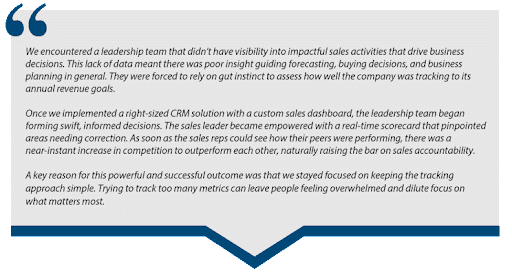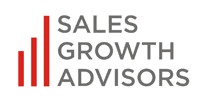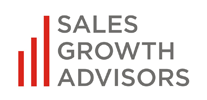Your company has revenue goals to hit. Each person on your sales team has a quota to hit.
There are a lot of moving parts to keep track of. If you’re still manually tracking sales
activity, you’re probably investing a large amount of your time and generating sub-par
visibility.
The small and mid-sized companies I work with all have one thing in common. They need help
developing and implementing an insightful sales dashboard. Maybe you’ll find this real-world
story relatable if this area hasn’t hit the top of your list yet?

Why You Need a Sales Dashboard

If you find yourself overwhelmed with the volume of data you’re tracking and you lack clear
visibility on sales performance until a new deal is closed, you will benefit from a sales
dashboard.
An effective sales dashboard, commonly referred to as a sales scorecard, monitors the sales
pipeline, including key conversion points in your sales process. These are things that have the
tendency to get held up such as new introduction meetings that turn into proposals.
Knowing where and when things are stuck in the sales process alerts the sales leader
with real-time visibility on where sellers need help navigating a deal before it’s too late. It
also pinpoints areas where sellers would benefit from additional training.
In my previous article, How Can I Build an Accountable Sales Culture? you’ll also see how
tracking the stats and performance of your sales team naturally creates a high-performance
sales culture. This is one of those invisible superpowers that top sales organizations always
embody.
My clients have seen incredible success after they’ve developed, implemented, and embraced
the sales dashboards we created together. To help you quantify the value that comes from
focusing in this area, here are the top 4 benefits my clients tend to enjoy the most.
Top 4 Benefits of a Sales Dashboard
1. Real-time Reporting– Having data you can trust at your fingertips is powerful. If
your sales team is working remotely, this offers you a ‘window’ into their daily
activities, struggles, and successes. You can remain in the loop and stay
connected to your salespeople, even when you might go days without seeing or
talking with one another.

2. Objective Conversations– The dashboard is made up of straight facts and numbers, not how sellers may feel they are doing. This opens the door to ultra-productive conversations in your 1:1 sales meetings because ‘facts are facts’. Use the dashboard to coach your salespeople on moving deals through the pipeline more swiftly, keeping focus on securing new customer meetings, and achieving productive meeting-to-opportunity conversation rates.
3. Team Benchmarking– When your dashboard is designed to provide comparative data across team members, best practice sharing becomes a staple function in your sales meetings. Your dashboard also allows you to isolate seller strengths that can be studied and replicated, such as heightened close rates, volume of new versus current account deal flow, strong ratio of high-profit products and services, or strongest lead source across the team.
4. Self-Directed Motivation*- By providing your salespeople with visibility into their personal scorecard, it enables them to monitor their own performance. It creates natural self-motivation when they understand how much more effort it will take to achieve the next gate on their comp plan or how they are performing versus their peers, or even how they are measuring up to their own historic activity trends that led to previous success. Creating a method for your salespeople to be self-directed creates the empowerment that breads high performance.
* Learn how the score card can be positioned as a motivation tool in my previous article How to Drive The Right Sales Behavior With Your Compensation Plan.
Avoid Making These Mistakes
I’d be remised remiss not to key in on some of the culprits that can kill a sales dashboard’s effectiveness. These are some of the most common:
- Lack of Communication- Don’t implement a sales dashboard before getting feedback from your team. Communicate the goals you have, listen to any concerns or questions they ask, and train your people on the benefits of this new tool. Pave the way by involving your team so your scorecard is embraced when it goes live.

- Overcomplicated – Keep the dashboard simple. Let the dashboard tell you what work needs to be done with the sales team but don’t clutter it with every single piece of data you can find. Identify the right things to track to create an easy-to-understand guide for your team to use.
- Micro-Measuring– Make sure your dashboard focuses on the quality and not just the quantity of your activity. Remember, your dashboard is a high-level view. You can dive in later to assess the volume of activity running through each seller’s scorecard if you notice pipeline volume is not growing as it should. Focus on the key milestones in your sales process that are strong leading indicators that the seller is progressing at a steady pace toward their revenue goal.
- Difficult Tracking- Make it a priority at launch that the dashboard will be updated on a regular basis, ideally real-time through use of a Customer Relationship Management (CRM) system. Don’t create metrics that cannot be easily tracked such as gross margin. When you have a multitude of products where costs tend to vary on a daily basis, your gross margin is a constantly moving target. Metrics need to be readily accessible to the salesperson and sales leader in order to serve as a real-time, automated guide.
While a sales dashboard is a great tool for tracking your successes and failures, it is not the sole solution for fixing an underperforming sales department. It’s a component within a best practices sales infrastructure that will help you determine where you should apply your focus and energy.
I have decades of experience building winning, results-driven sales organizations and would enjoy sharing that value with you.
If you’d like to have a preliminary discussion about the sales challenges you are facing, please feel welcome to contact me at Chris @ Sales Growth Advisors or book a call through my Scheduling Tool.
I also invite you to follow me on LinkedIn to gain exposure to future article posts that will offer more valuable selling insights.
TAKE MY SALES AGILITY ASSESSMENT
——————————————————————————————————————————
I am part of a national group of Senior Sales Leaders who collaborate to share insights like the examples shown in this article. We formed because of our shared passion to help business leaders exponentially grow their revenue.
Chris Tully
President | Sales Growth Advisors LLC

(Phone) 571-329-4343
(Email) crtully@salesgrowthadvisor.com
(Schedule) Here is my calendar link!







Leave A Comment